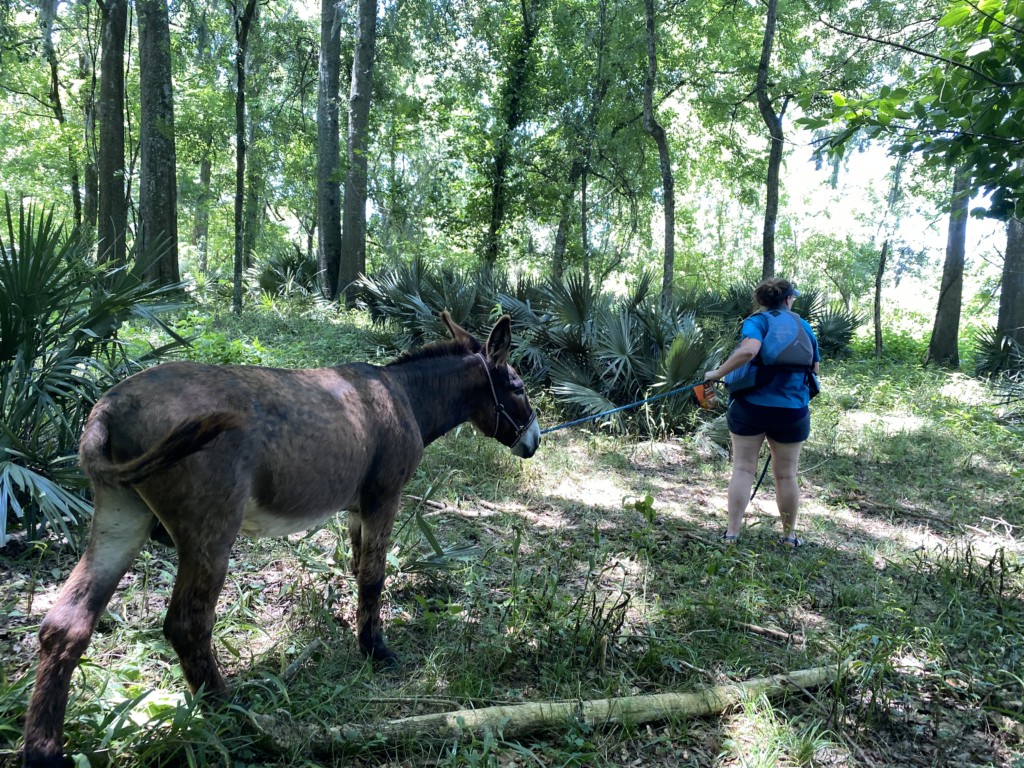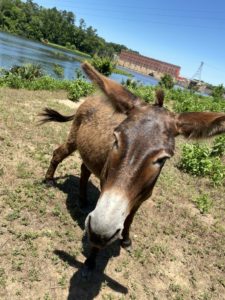Donkeys and goats were introduced on Stallings Isliand in 2008 to control plant overgrowth. Recently, an ill-mannered male donkey had to be removed from the island – and it was no small feat.
Augusta, Georgia | Stallings Island is a National Landmark site in Augusta, Georgia that was occupied by Indigenous hunter-gathers for thousands of years. When the Archaeological Conservancy acquired the property from Wyck and Shell Knox in 1997, the prehistoric archaeological site was the scene of frequent and aggressive looting. The immense, brushy overgrowth that had formed on the island offered the perfect cover for looters to go unnoticed for many years. Between the efforts of the Conservancy and the staff of Stevens Creek Hydroelectric Dam, looting and trespassing was greatly reduced, but overgrowth was a continual problem.
In 2008, the Archaeological Conservancy launched a costly operation to clear the thick overgrowth, add sterile soil, and plant grass at the heart of the archaeological site. The operation was conducted at the tune of around $50,000 and involved the construction of a special barge to transport equipment, dirt, and supplies to area. A species of goat, that once roamed the island before being wiped out by predators, was reintroduced to combat the overgrowth between mechanical mowings, and donkeys were introduced to protect the goats from the menace of wild dogs. This plan came with unforeseeable circumstances that had to be contended with as issues arose, such as inbreeding and fights caused by dominant males among the donkeys. As a result, local veterinarians and farriers volunteered to visit the site and care for the animals on a regular basis. Food also had to be imported to supplement natural grasses in the winter. Diminished plant growth on the island reduced trespassing and looting considerably, but not entirely. Kayakers still frequent the island and the charming donkeys lure them in for carrot and apple treats.
Over the last two years, a couple of donkeys were killed and Southeastern Regional Director, Jessica Crawford, began to receive reports of an aggressive male donkey attacking and inflicting injuries on some of the juvenile donkeys. The decision was made to relocate Buster, the offending male donkey, to a local refuge. Local volunteers on the effort included a vet and farrier, the owners of two local outfitters, the Director of Savannah Riverkeeper, a member of Veterans for Clean Water, and staff members from Big Oaks Rescue Farm, who agreed to give Buster a safe and happy home.
Buster was attached to a rope and outfitted with a life jacket for his swim to the opposing shore. This was a new experience for Buster, so it took some coercing to get him to the water. He was attached to a boat that helped him swim across the river. Although the distance was short, the operation took some time, as Buster needed time to rest now and then. Ultimately, he made it safely across and is now living a happy life at Big Oaks Rescue Farm.
While the donkey is no longer a threat, the Conservancy is now faced with a new problem, as the grass and weeds now growing on the island are undesirable to both the goats and donkeys who live there. The prevailing problem ensues as the site has been consumed by overgrowth once again. New conservation plans are being considered at Stallings Islands with a focus on preserving and protecting the precious archaeological resources and the safety of the animals that now call the site home.
About Stallings Island
Stallings Island played a pivotal role in the cultural landscape of the Southeast during the Late Archaic period (3000-1000 B.C.). Archaeologist speculate that the origins of the Stalling culture began about 5,000 years ago in the Lower Savannah River Valley. The culture produced the oldest documented pottery in North America, the first local shell fishing, and the regions first settlements. The Stalling Island people lived in semi-permanent villages along the shoals of the Savannah and Oggeechee Rivers where they could have easy access to freshwater shellfish, producing large shell middens. People at Stallings Island lived in round houses made from bent saplings covered with skins or bark that are thought to be arranged around a circular plaza. They produced the earliest forms of decorated pottery, along with carved bone pins, banner stones, and stemmed projectile points.
The Stalling Island site has been the source of study and conjecture by archaeologists since 1873. The most recent work was conducted by Dr. Kenneth Sassaman, Professor of Archaeology at the University of Florida, in 1999. Dr. Sassaman is the foremost expert on Stallings Island and Stallings culture, and author of the book “People of the Shoals: Stallings Culture of the Savannah River Valley’. Through the Conservancy’s preservation and protection efforts, researchers continue their research into the site’s prehistoric past.





